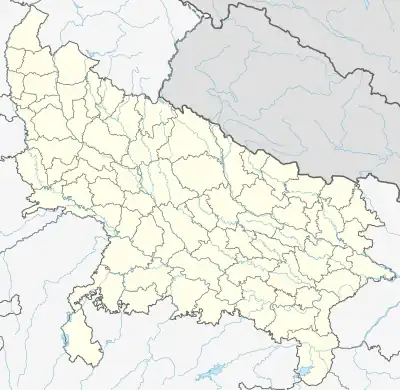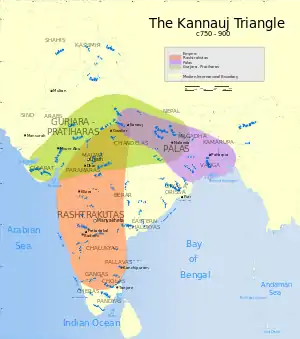| Ghaznavid invasion of Kannauj | |||||||||
|---|---|---|---|---|---|---|---|---|---|
| Part of Ghaznavid campaigns in India | |||||||||
.jpg.webp) Kannauj | |||||||||
| |||||||||
| Belligerents | |||||||||
|
| Gurjara-Pratihara dynasty | ||||||||
| Commanders and leaders | |||||||||
|
|
Rajyapala | ||||||||
| Casualties and losses | |||||||||
| unknown | heavy | ||||||||
 Kannauj Kannauj  Kannauj Kannauj (Uttar Pradesh) | |||||||||
The Ghaznavid invasion of Kannauj or the siege of Kannauj in 1018 was a military campaign conducted by Mahmud of Ghazni, the then ruler of the Ghaznavid Empire, against the Gurjara-Pratihara dynasty. During this siege, the Gurjar ruler, Rajyapala, eventually surrendered to Mahmud of Ghazni, thereby accepting nominal suzerainty under his rule. This event marked the decline of the Gurjara dynasty's power. In the aftermath of his surrender to Mahmud, Rajyapala met his demise at the hands of the Chandela ruler, Vidhyadara, for capitulating to the Ghaznavid conqueror.
Background
Mahmud of Ghazni, as the ruler of the Ghaznavid Empire, conducted a series of invasions into India. One of his notable campaigns was the invasion of Kannauj, which was the capital of the Gurjara-Pratihara dynasty. Prior to reaching North India, he first defeated the Hindu Shahis of Afghanistan and various other regional monarchs in northern India.[1]
In 1018, Mahmud of Ghazni, led an expedition from Ghazni with the aim of capturing Kannauj from the Gurjara-Pratihara dynasty. Kannauj held strategic significance, being at the crossroads of power for the Pala dynasty, the Gurjara-Pratihara dynasty, and the Rashtrakutas.[2] These dynasties had been vying for control of Kannauj, but in 1018, the ruler of the Gurjara-Pratihara dynasty, Rajyapala, held dominion over the city.[3][4]

On his journey to Kannauj, Mahmud captured Bulandshahr and Mahaban after defeating their rulers. He also entered Mathura and looted its vicinity.[5][6]
The invasion
In January 1019, Mahmud of Ghazni reached Kannauj. Surprisingly, Rajyapala, the ruler of Kannauj, offered no resistance and fled his capital by crossing the Ganga River, ultimately seeking refuge in Bari. In his absence, Ghaznavid forces ransacked Kannauj, seizing a substantial amount of plunder.[7][8]
Ultimately, Rajyapala, after fleeing to Bari, decided to surrender to Mahmud, acknowledging the nominal suzerainty of the Ghaznavids. The seven forts of Kannauj fell in one day to the Ghaznavids. Following this development, Mahmud engaged in other campaigns within India after successfully asserting control over Kannauj.[9][10][11][12]
Aftermath
Rajyapala's surrender to the Ghaznavids had consequences, leading to some turn of events. The Chandela ruler Vidyadhara, along with his allies, took matters into their own hands and killed Rajyapala.[12] Meanwhile, Mahmud of Ghazni continued his campaign, capturing the fort at Munjhawan, a stronghold held by Brahmins.[1] These actions effectively marked the end of the Gurjara-Pratihara dynasty.[13][14]
References
- 1 2 Gupta, Nilima Sen (1984). Cultural History of Kapisa and Gandhara. Sundeep. pp. 49–56. ISBN 978-81-7574-027-3.
- ↑ Majumdar, Ramesh Chandra (1977). Ancient India. Motilal Banarsidass Publ. pp. 282–285. ISBN 978-81-208-0436-4.
- ↑ Dikshit, R. K. (1976). The Candellas of Jejākabhukti. Abhinav Publications. pp. 88–92. ISBN 978-81-7017-046-4.
- ↑ Encyclopedia of India: D to H. Encyclopaedia Britannica (India) Pvt. Limited. 2008. p. 229. ISBN 978-81-8131-008-8.
- ↑ Mishra, Yogendra (1972). The Hindu Sahis of Afghanistan and the Punjab, A.D. 865-1026: A Phase of Islamic Advance Into India. Vaishali Bhavan. p. 196.
- ↑ Chakrabarty, Dilip K. (2010-10-18). The Geopolitical Orbits of Ancient India: The Geographical Frames of the Ancient Indian Dynasties. Oxford University Press. ISBN 978-0-19-908832-4.
- ↑ Ratnawat, Shyam Singh; Sharma, Krishna Gopal (1999). History and Culture of Rajasthan: From Earliest Times Upto 1956 A.D. Centre for Rajasthan Studies, University of Rajasthan. pp. 91–92.
- ↑ Sharma, L. P. (1989). History of Medieval India (1000-1740 A.D.). Konark Publishers. pp. 8–10. ISBN 978-81-220-0042-9.
- ↑ Farooqui, Salma Ahmed (2011). A Comprehensive History of Medieval India: Twelfth to the Mid-eighteenth Century. Pearson Education India. p. 48. ISBN 978-81-317-3202-1.
- ↑ Bakshi, S. R.; S.G (2005). Early Aryans to Swaraj. Sarup & Sons. p. 366. ISBN 978-81-7625-537-0.
- ↑ Hooja, Rima (2006). A History of Rajasthan. Rupa & Company. pp. 192–193. ISBN 978-81-291-0890-6.
- 1 2 Sen, Sailendra Nath (1999). Ancient Indian History and Civilization. New Age International. pp. 345–355. ISBN 978-81-224-1198-0.
- ↑ Mitra, Sisir Kumar (1977). The Early Rulers of Khajur (Second Revised ed.). Motilal Banarsidass Publ. pp. 72–73. ISBN 978-81-208-1997-9.
- ↑ Chandra, Satish (2004). Medieval India: From Sultanat to the Mughals-Delhi Sultanat (1206-1526) - Part One. Har-Anand Publications. pp. 19–20. ISBN 978-81-241-1064-5.